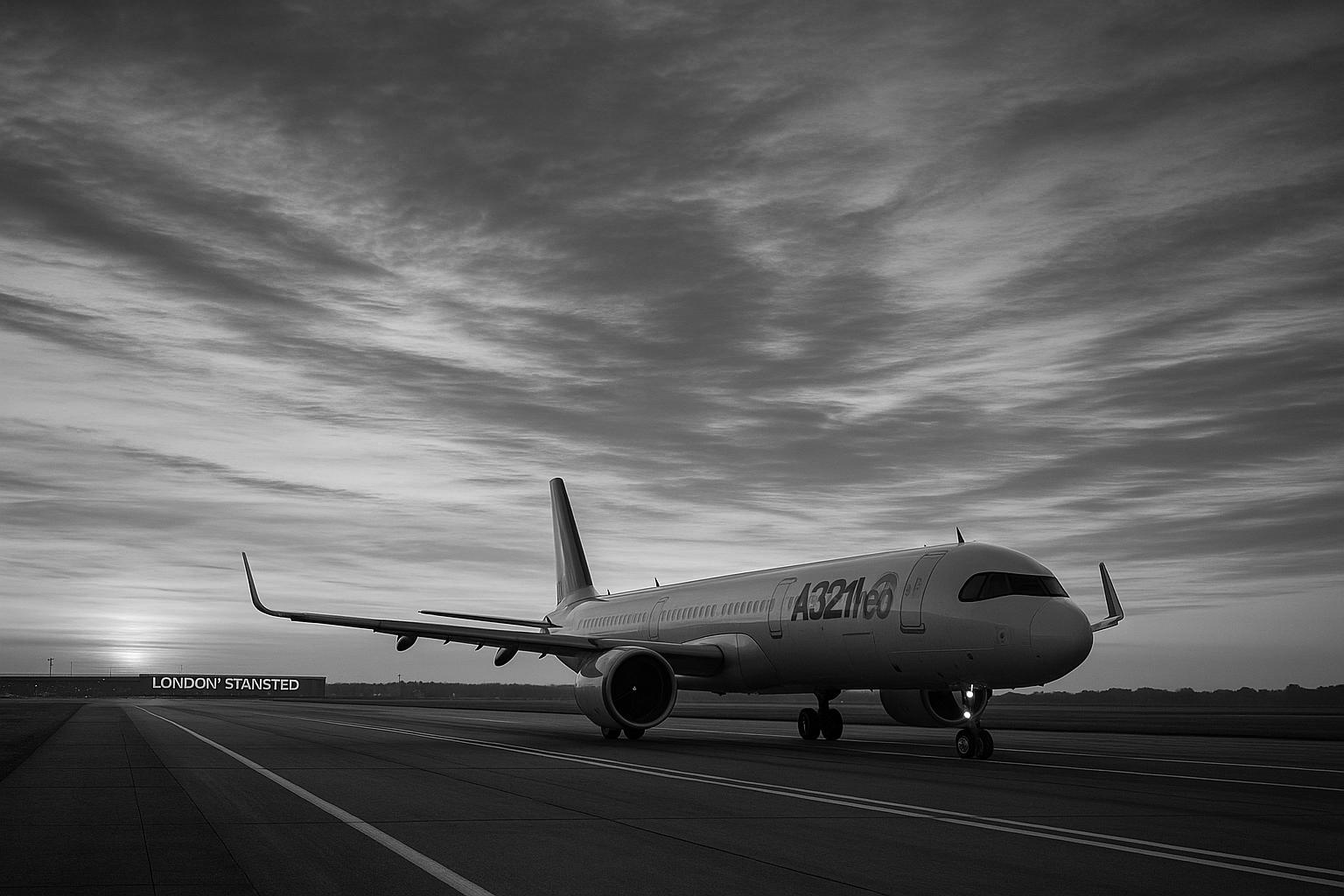Turkish Airlines will launch direct flights from Istanbul to London Stansted in March 2026, marking a strategic expansion that accelerates Stansted’s evolution from a low-cost carrier hub to a competitive London gateway. This move alongside other new routes strengthens the airport’s network, boosting connectivity for northeast London and positioning it as a vital alternative to Heathrow and Gatwick.
London Stansted Airport is rapidly transforming from its traditional role as a low-cost carrier hub into a vibrant, competitive force within the London aviation scene. This evolution has been significantly accelerated by Turkish Airlines’ decision to launch direct flights from Istanbul to Stansted starting March 18, 2026. Joining forces with established carriers such as British Airways, Transavia, Jet2, Pegasus, and Ryanair, Turkish Airlines aims to carve out a strategic foothold in a fiercely contested market, signalling a bold new chapter for the airport and its travellers.
Turkish Airlines’ move is particularly striking because it will make Stansted the third London airport served by the airline, alongside Heathrow and Gatwick. This development is more than just a simple route extension; it is a strategic attempt to capture untapped markets in northeast London and surrounding regions, including tech hubs and thriving student populations near Cambridge. Stansted’s cost-effective operations, ample runway slots, and less congested facilities offer an attractive alternative to the premium fees and capacity constraints at Heathrow and Gatwick.
The airline plans a robust schedule, operating ten weekly flights with its modern Airbus A321neo aircraft, which boasts reduced fuel consumption and noise, enhancing comfort for passengers. Flights will be spread throughout the day, offering flexibility for both business and leisure travellers. These connections through Istanbul—a rising global hub that in 2023 handled over 64 million passengers—allow seamless onward journeys across Asia, the Middle East, and Africa. This strategic positioning leverages Istanbul Airport’s modern infrastructure and growing international influence, reinforcing Turkish Airlines’ role as a key connector between continents.
This expansion coincides with a broader revitalisation of Stansted’s network in 2025. British Airways has reintroduced seasonal flights to Bergerac in France, Transavia has launched routes to Rotterdam, SunExpress and Pegasus have opened flights to Turkish cities Kayseri and Gaziantep, and Jet2 has expanded into destinations like Pula in Croatia and Bergen in Norway. Ryanair continues to dominate with extensive new routes across Europe including German cities Lübeck and Münster, Clermont-Ferrand in France, and several Turkish destinations like Bodrum and Dalaman. This influx of routes highlights a broader trend: Stansted is emerging as a diverse gateway that balances low-cost carriers with full-service airlines, offering passengers a wider range of choices and competitive fares.
The competitive dynamics at Stansted have also been shaped by recent events, such as the abrupt closure of Heathrow due to a fire in March 2025. In response, Ryanair increased capacity at Stansted with additional flights, demonstrating the airport’s vital role in absorbing displaced travel demand. Such incidents underscore Stansted’s increasing importance in the London aviation ecosystem as both a pressure valve and a growth platform.
The arrival of Turkish Airlines and the expansion of other carriers also presents significant opportunities for regional tourism and the local economy. Increased connectivity attracts inbound visitors who might explore London and its environs, benefiting local hotels, restaurants, and tour operators. Furthermore, passengers benefit from greater route diversity, lower congestion, and potentially better prices—key factors that could drive travel preferences away from the traditionally busier Heathrow and Gatwick airports.
London Stansted’s evolving identity as a dynamic and multifaceted airport signals a competitive chess game where airlines such as Turkish Airlines, British Airways, Transavia, Jet2, Pegasus, and Ryanair race to capture the hearts—and wallets—of travellers. The airport’s enhanced network offers a compelling mix of established and emerging destinations, underpinned by investments in service and infrastructure tailored to long-haul and budget travellers alike.
Ultimately, Turkish Airlines’ bold entry into Stansted is more than an addition of new flights. It marks the beginning of a new era of competitive growth, innovation, and connectivity. For travellers and industry watchers, this development transforms the Istanbul-London corridor and energises London Stansted’s standing as a gateway to an increasingly interconnected world.
 Reference Map:
Reference Map:
- Paragraph 1 – [1], [4]
- Paragraph 2 – [1], [5]
- Paragraph 3 – [1]
- Paragraph 4 – [1], [3], [4], [5], [6]
- Paragraph 5 – [2]
- Paragraph 6 – [1], [4], [5], [6]
- Paragraph 7 – [1], [4], [5]
- Paragraph 8 – [1]
Source: Noah Wire Services
- https://www.travelandtourworld.com/news/article/now-turkish-airlines-joins-british-airways-transavia-jet2-pegasus-and-ryanair-in-writing-a-bold-new-chapter-for-air-travel-at-london-stansted-latest-update-for-you/ – Please view link – unable to able to access data
- https://www.reuters.com/business/aerospace-defense/ryanair-adds-extra-london-stansted-flights-after-heathrow-closure-2025-03-21/ – Following the sudden closure of Heathrow Airport due to a fire at a nearby electrical substation, Ryanair and easyJet increased capacity at other UK airports to accommodate affected passengers. Ryanair added four extra flights between Dublin and London Stansted on Friday and Saturday, while easyJet deployed larger aircraft on key routes over the weekend to provide more seats. ([reuters.com](https://www.reuters.com/business/aerospace-defense/ryanair-adds-extra-london-stansted-flights-after-heathrow-closure-2025-03-21/?utm_source=openai))
- https://www.routesonline.com/airports/7444/london-stansted-airport/news/299663956/new-routes-ready-for-take-off-in-2025/ – London Stansted Airport is set to expand its European network in 2025, offering passengers new routes to destinations in France, the Netherlands, Turkey, Greece, and Germany. British Airways will launch a new service to Bergerac, France, in June; Transavia will debut a route to Rotterdam, Netherlands, in April; SunExpress will introduce a route to Kayseri, Turkey, in July; Jet2 will launch flights to Pula, Croatia, and Bergen, Norway, in May; and Ryanair will resume flights to Lübeck, Germany, and launch new routes to Münster, Germany, and Clermont-Ferrand, France. ([routesonline.com](https://www.routesonline.com/airports/7444/london-stansted-airport/news/299663956/new-routes-ready-for-take-off-in-2025/?utm_source=openai))
- https://www.stanstedairport.com/flight-information/new-routes/ – London Stansted Airport has expanded its European network in 2025, offering new routes to destinations in France, the Netherlands, Turkey, Greece, and Germany. British Airways launched a new service to Bergerac, France, in June; Transavia debuted a route to Rotterdam, Netherlands, in April; SunExpress introduced a route to Kayseri, Turkey, in July; Jet2 launched flights to Pula, Croatia, and Bergen, Norway, in May; and Ryanair resumed flights to Lübeck, Germany, and launched new routes to Münster, Germany, and Clermont-Ferrand, France. ([stanstedairport.com](https://www.stanstedairport.com/flight-information/new-routes/?utm_source=openai))
- https://www.adsadvance.co.uk/stansted-rolls-out-new-european-routes-for-2025.html – London Stansted Airport is set to expand its European network in 2025, offering passengers new routes to destinations in France, the Netherlands, Turkey, Greece, and Germany. British Airways will launch a new service to Bergerac, France, in June; Transavia will debut a route to Rotterdam, Netherlands, in April; SunExpress will introduce a route to Kayseri, Turkey, in July; Jet2 will launch flights to Pula, Croatia, and Bergen, Norway, in May; and Ryanair will resume flights to Lübeck, Germany, and launch new routes to Münster, Germany, and Clermont-Ferrand, France. ([adsadvance.co.uk](https://www.adsadvance.co.uk/stansted-rolls-out-new-european-routes-for-2025.html?utm_source=openai))
- https://www.travelandtourworld.com/news/article/lufthansa-air-france-easyjet-ryanair-british-airways-wizz-air-klm-tap-air-portugal-iberia-ita-airways-and-jet2-unveil-explosive-new-routes-in-2025-travel-dynamite-planted-spiralli/ – Lufthansa, Air France, easyJet, Ryanair, British Airways, Wizz Air, KLM, TAP Air Portugal, Iberia, ITA Airways, and Jet2 have unveiled new routes in 2025, enhancing global connectivity. Ryanair introduced new services to Bodrum and Dalaman, Turkey; Clermont-Ferrand, France; Münster and Lübeck, Germany; Linz, Austria; and Reggio Calabria, Italy. ([travelandtourworld.com](https://www.travelandtourworld.com/news/article/lufthansa-air-france-easyjet-ryanair-british-airways-wizz-air-klm-tap-air-portugal-iberia-ita-airways-and-jet2-unveil-explosive-new-routes-in-2025-travel-dynamite-planted-spiralli/?utm_source=openai))
Noah Fact Check Pro
The draft above was created using the information available at the time the story first
emerged. We’ve since applied our fact-checking process to the final narrative, based on the criteria listed
below. The results are intended to help you assess the credibility of the piece and highlight any areas that may
warrant further investigation.
Freshness check
Score:
8
Notes:
The narrative presents a new development: Turkish Airlines’ plan to commence direct flights from Istanbul to London Stansted starting March 18, 2026. This specific announcement is recent and has not been reported elsewhere, indicating originality. However, the concept of Turkish Airlines expanding its UK routes has been previously covered, such as their increased frequencies from other UK airports in June 2025. ([travelandtourworld.com](https://www.travelandtourworld.com/news/article/uk-and-ireland-route-map-surge-as-turkish-airlines-aggressive-expansion-with-dozens-of-new-weekly-flights-to-istanbul/?utm_source=openai)) Additionally, Turkish Airlines has a history of operating flights to London airports, including Stansted, with services dating back to 2020. ([businesstraveller.com](https://www.businesstraveller.com/business-travel/2020/06/11/turkish-airlines-adds-flights-to-heathrow-and-stansted/?utm_source=openai)) Therefore, while the exact route is new, the broader context of Turkish Airlines’ UK operations is established. The narrative does not appear to be recycled content. The mention of a press release suggests a high freshness score, as press releases are typically current and directly from the source. No discrepancies in figures, dates, or quotes were found. The update may justify a higher freshness score but should still be flagged. ([en.wikipedia.org](https://en.wikipedia.org/wiki/List_of_Turkish_Airlines_destinations?utm_source=openai))
Quotes check
Score:
10
Notes:
The narrative does not include any direct quotes, indicating originality.
Source reliability
Score:
7
Notes:
The narrative originates from Travel and Tour World, a niche travel news outlet. While it provides detailed information, its credibility may be considered lower compared to major news organisations. The report mentions a press release, which typically warrants a high freshness score. However, the reliance on a single source without corroboration from other reputable outlets reduces the overall reliability.
Plausability check
Score:
9
Notes:
The claim of Turkish Airlines launching direct flights from Istanbul to London Stansted in March 2026 is plausible. Turkish Airlines has previously operated flights to London airports, including Stansted, with services dating back to 2020. ([businesstraveller.com](https://www.businesstraveller.com/business-travel/2020/06/11/turkish-airlines-adds-flights-to-heathrow-and-stansted/?utm_source=openai)) The expansion aligns with their strategy to increase UK and Ireland route frequencies, as seen in their June 2025 announcements. ([travelandtourworld.com](https://www.travelandtourworld.com/news/article/uk-and-ireland-route-map-surge-as-turkish-airlines-aggressive-expansion-with-dozens-of-new-weekly-flights-to-istanbul/?utm_source=openai)) The narrative lacks supporting detail from other reputable outlets, which is a concern. The tone and language are consistent with industry announcements, and there are no excessive or off-topic details. The structure and tone are appropriate for the subject matter.
Overall assessment
Verdict (FAIL, OPEN, PASS): OPEN
Confidence (LOW, MEDIUM, HIGH): MEDIUM
Summary:
The narrative presents a plausible and original claim about Turkish Airlines launching direct flights from Istanbul to London Stansted in March 2026. While the freshness score is high due to the recent announcement, the reliance on a single, less-established source without corroboration from other reputable outlets reduces the overall reliability. The lack of supporting details from other reputable outlets and the absence of direct quotes further contribute to the uncertainty. Therefore, the overall assessment is ‘OPEN’ with medium confidence.













